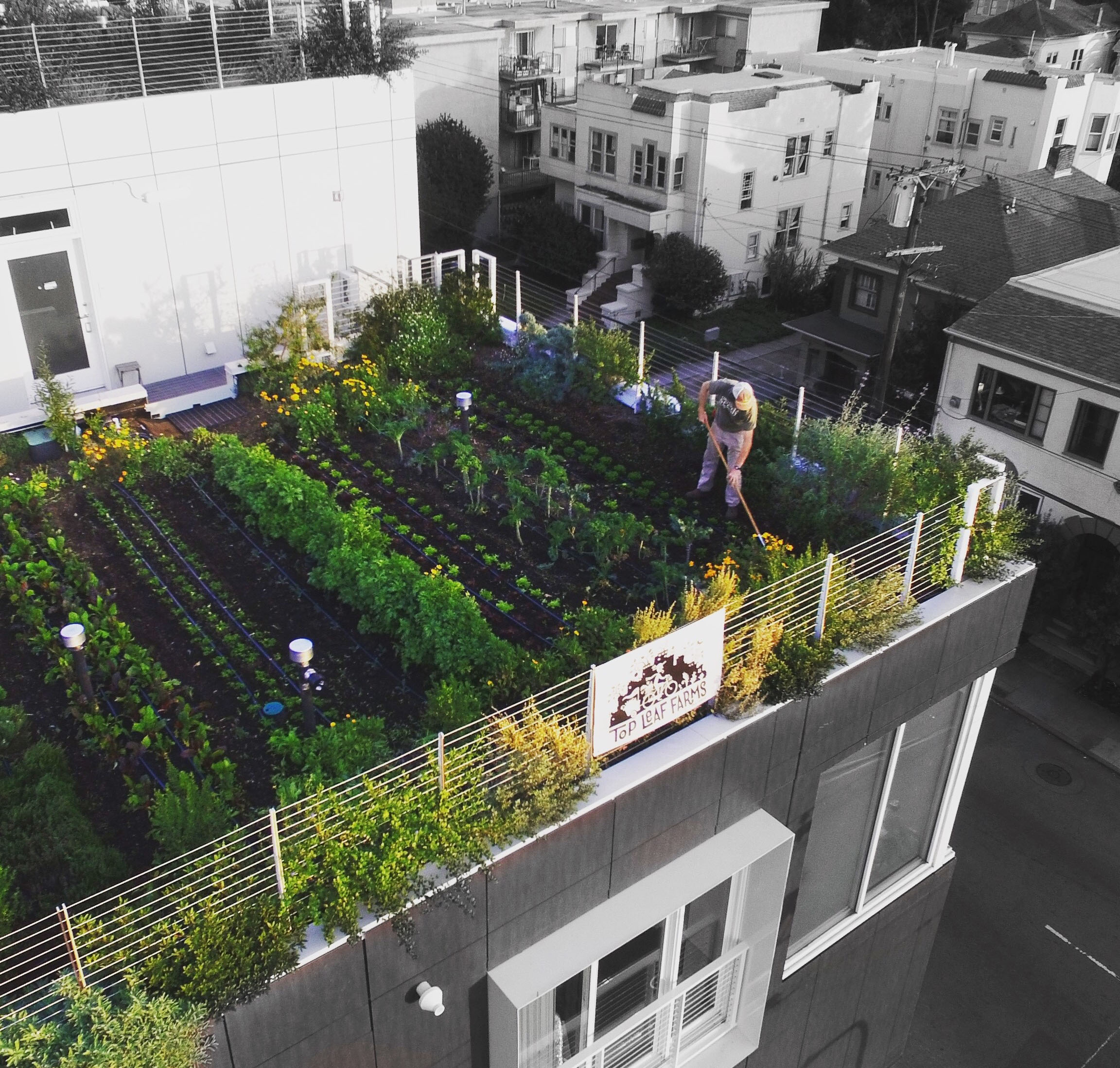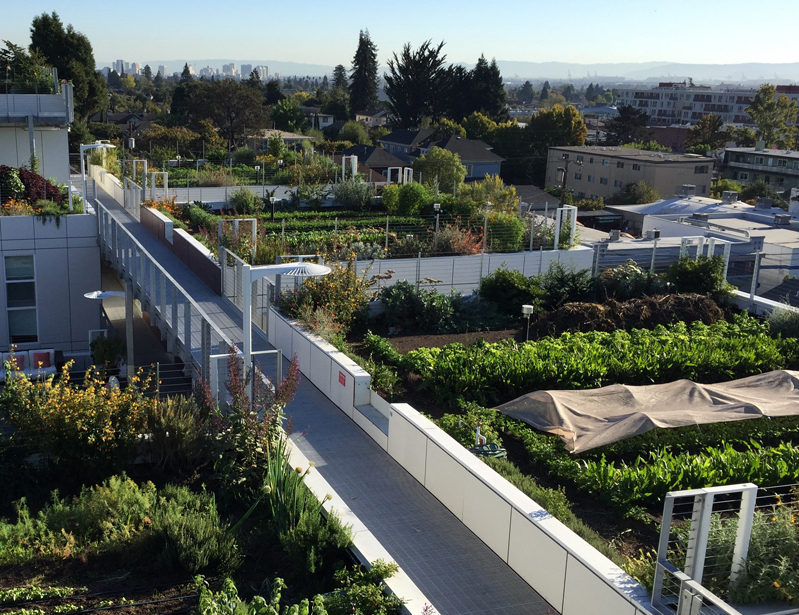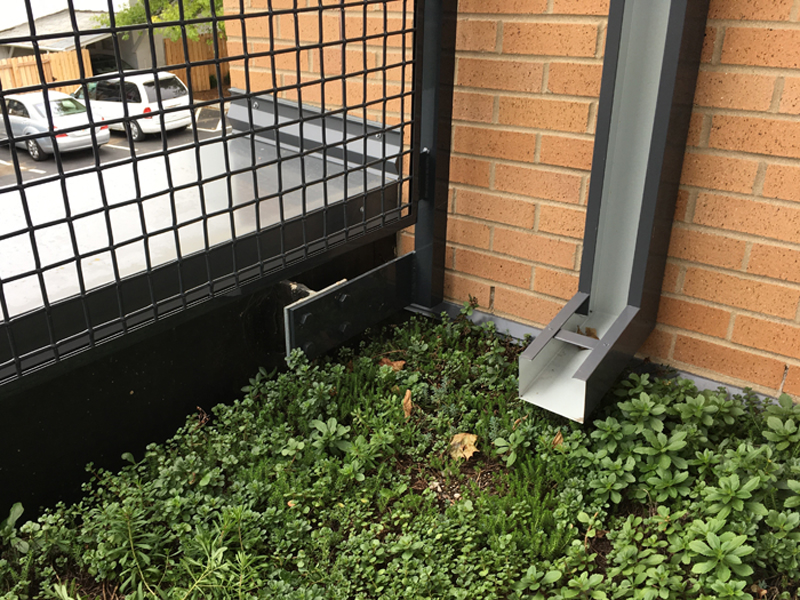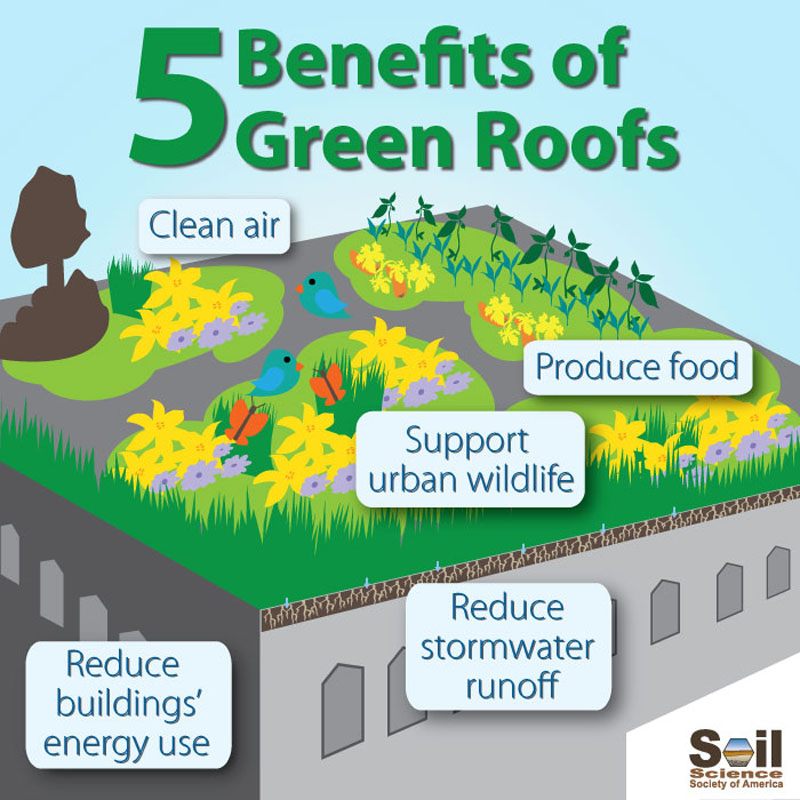
Green roofs
Types of green roofs
Green roofs are designated as extensive, semi-intensive, or intensive. The designation depends on their depth, type of vegetative cover, and function.
Extensive green roofs are low-maintenance. They have shallow soils or other growing media that are well-suited for low-growing plants like Sedum and other succulent species. They primarily function as an ecological protection layer, such as a filter for stormwater. These green roofs are typically maintained at only 3 to 5 inches high and are not usually irrigated. They are shallow and covered with low-growing grasses, herbs, or succulents. This helps extensive green roofs to be well-suited for roofs with little load bearing capacity. The weight of an extensive green roof will range from about 13 to 30 pounds per square foot. Extensive green roofs are also the least expensive green roof type.
In contrast to extensive green roofs, intensive green roofs contain a greater variety of plant types. They also require greater maintenance and inputs of fertilizer and water. An intensive green roof is designed to look much like a city park, with lawns, perennials, bushes, and trees. Some intensive green roofs even have benches, ponds, or playgrounds built into their designs. Green roofs used for rooftop farming are one example of an intensive system. Intensive green roofs require a roof with high load-bearing capacity, as they may weigh 35 to 80+ pounds per square foot. They will also require a permanent irrigation system and are the most labor-intensive and expensive green roof type.
In between extensive and intensive are semi-intensive green roofs, which are grown 5 to 7 inches high with perennials, small shrubs, and ornamental grasses. They do not contain tall-growing bushes or trees. Semi-intensive green roofs have moderate watering and maintenance needs and are suited for roofs that can support 25 to 40 pounds per square foot of load. They function as stormwater filters and habitat for urban wildlife.
There are also monolithic and modular green roofs. A monolithic green roof is one where all components are placed on the roof in layers and plant roots are free to intertwine with those of adjacent plants all across the roof. A modular green roof system, on the other hand, is made up of multiple containers or green roof trays. These trays contain all the components of a green roof, such as drainage, root containment, growing media, and plants.
Green Roof Standards
Viewed from the surface, green roofs appear to be natural. However, the material beneath the plants is typically composed of an engineered growing medium. The medium is high in minerals and low in organic matter (less than 8%). Research on the best growing media for green roofs was pioneered in Germany and Switzerland. In the 1970s, a group of German researchers developed the FLL German Guidelines for Rooftop Greening, which aided those developing, designing, and constructing vegetated roofs.
When creating the growing medium for a green roof, designers need to consider several factors:
- the composition of the medium;
- its drainage characteristics; and,
- the fertility requirements of plants.
During the 1980s, there were major advancements to development of lightweight growing mediums. This allowed green roofs to become part of standard building construction worldwide. Today, the FLL Guidelines represent the state-of-the-art performance specifications for green roofs abroad. In North America, guidelines and standard tests for green roof construction and maintenance, including the American Standard Testing Methods (ASTM) guideline, are being developed. A non-profit organization, Green Roofs for Healthier Cities (GRHC), is a leading organization for green roof industry standards in North America (www.greenroofs.org). GRHC has partnered with green roof manufacturers and the American National Standards Institute to develop industry standards related to fire prevention, wind uplift, and root repellency.
Always check with local building code offices before beginning a green roof construction process. One of the most important considerations will be the load-bearing capacity of the existing roof. Local building code offices will have information on how to check the structural requirements of your green roof design. In most cases, a building permit must be obtained to begin and carry out a green roof project. Check with your state or county building code office for more information.
Growing rooftop crops
Herbs and vegetables are often grown on green roofs in containers, although plants may be grown directly in specialized growing medium or soil. In the latter case, though, the load-bearing capacity of the roof needs to support a deep (greater than 8 inches) soil layer and the additional weight of the water necessary for the plants. Edible plants chosen for a rooftop garden can be “patio” or dwarf varieties that are designed for containers and small spaces. In general, heat-loving plants such as peppers, tomatoes and basil often do well on rooftop gardens. Crops like peas and spinach that require cooler conditions may not do as well. Look for plant varieties that are well adapted to heat and slow to bolt when the sun is intense.
Special considerations for rooftop gardens include sun exposure, wind, temperature, and access. Rooftop gardens are seldom shaded, excess sun exposure can be a problem for some food plants. The plants may also require extra watering to fight against the damaging effects of constant sun and higher temperatures. Overhead irrigation on rooftop gardens often blows away, so drip irrigation is a better choice when irrigation is necessary. Soils on rooftops will dry out faster after rainfall than will soils on the ground. Mulching soil can help keep it moist in between rain or irrigation. Also, wind speeds double for every 10 stories of building height, so it may also be necessary to stabilize plants and/or containers.
It’s also important to consider how people will safely access the garden to fertilize, water, and harvest. A structural engineer may need to be consulted to ensure the garden doesn’t exceed the load-bearing capacity of the roof. A garden can exert 80 to 150 pounds per square foot, and any irrigation water stored on the roof will weigh about 8 pounds per gallon. But the soil or growing medium will need to be kept moist, because food plants aren’t as drought-tolerant as many non-food plants. Wet soil is heavy, so a lightweight growing medium is most practical for rooftop gardens. Never use regular potting soil or ground soil for a rooftop garden. Specially-made growing media that are light in weight are necessary for the unique load-bearing limitations of most roofs.
Managing rainfall
Stormwater quantity
Green roofs’ soil and vegetation can catch and hold precipitation. This means that green roofs can be an important aid to reduce the amount of stormwater that runs off onto city streets.
Factors that affect the ability of a green roof to retain stormwater include the
- duration of the storm;
- how soon the storm occurred after the previous one; and
- the thickness of the growing substrate or soil.
Many studies show small to moderate storms are very effectively managed by green roofs. But, as you can imagine, there are challenges. Shallow substrates (1 to 2 inches) can only hold so much water. So, if there is irrigation before a rain event, or even a recent storm, the substrate can be challenged. The roof will capture much less precipitation, leading to more stormwater runoff.
Green roofs with substrates of moderate depths (4 to 5 inches) are very effective tools for managing storm water. In fact, the depth of growing media has been shown in most studies to be the most important factor in determining how well a green roof intercepts rainfall. On average, green roofs retain about 45 to 60 % of rainfall that hits them, with intensive roofs holding more rainfall than extensive roofs.
There are also variations among green roof systems. But modular systems that are expressly designed to retain stormwater can be very effective. However, it’s usually monolithic green roofs that excel at stormwater management. Monolithic green roofs do a better job of capturing stormwater because water moving through the roof is in contact with plants all along the drainage path. With modular green roofs, in contrast, once water drains underneath an individual modular container, it passes underneath adjacent containers and isn’t available to other plants before leaving the roof.
Stormwater quality
Simply by decreasing the volume of urban runoff, green roofs can also reduce the level of contaminants carried in stormwater. A drop in runoff volume means a reduction in the mass of contaminants that the stormwater can transport.
In addition, green roofs can improve stormwater quality. The soil or growing medium may be able to adsorb certain contaminants in urban air and precipitation. For example, heavy metals such as zinc, copper, and lead can all be removed from rain water to some degree by the soil’s natural ability to retain them. In one study, the green roof performed well – it was made of a lightweight, expanded shale and composted biosolids. Research continues regarding how to build better green roofs that reduce stormwater volume and improve quality.
Reducing heat in cities
Many cities around the world experience temperatures up to 10°F (5.6°C) warmer than the surrounding countryside. These areas are called “urban heat islands.” Their air surface temperatures are elevated more than usual. And, drought conditions are more pronounced than in nearby rural areas.
The effect occurs because urban surfaces, such as roads and buildings, tend to absorb heat from the sun. There are also far fewer trees and other plants to provide cooling through the process known as transpiration.
Among the biggest heat absorbers in cities are rooftops. Rooftops typically make up 5 to 35 percent of the urban landscape. The U.S. Environmental Protection Agency (EPA) reports that over 90 percent of the rooftops in the United States are dark in color. They also reflect very little sunlight – meaning they absorb all the incoming heat. As a result, city roof surfaces can reach temperatures of 150°-190°F (66°-88°C) during the summer. Yes, that’s hot enough to cook an egg!
When the roofs are this hot, it’s harder to cool the interior spaces of buildings. That means higher peak electricity demands, which can overburden city power grids. The level of air pollution in a city can also be intensified by the urban heat island effect. For example, higher temperatures in cities can increase levels of ground-level ozone. Ozone is a pollutant that causes respiratory problems.
Green roofs counteract the heat island effect
Green roof technology can help reduce urban heat islands and conserve energy. Green roofs have been shown to keep rooftops cooler than conventional roofs. They also have a cooling effect on a city’s surface temperatures. A study in the Baltimore-Washington metropolitan area showed that green roofs could cool the surface by nearly 2°F (1°C)! The project studied green roofs that covered at least 30% of the roof surface.
The biggest factor that influences how well green roofs work is the volume of moisture in the soil. It is important to keep the soil from becoming very dry or near the plant “wilting” point. So, it’s important to monitor how much water the plants are using and irrigate appropriately. But, adding too much water doesn’t help the cooling – and it’s wasteful of the water.
Green roofs can also reduce energy use across different climates. The amount of cooling by the green roof depends on what type of material is used for the roof. Green roofs are typically covered with a growing media that contains soil but is different from the soil on the ground. It is specially-made mixtures of soil and inorganic materials like crushed clay and perlite. This keeps the material lightweight and provides good water drainage.
Intensive green roofs offer more cooling and energy savings benefits than do extensive green roofs. The increased soil depth and plant density of intensive green roofs prevents heat from moving down to ceiling height. Energy use can be reduced 10 to 30 percent when a building has a green roof. This effect is more significant in hot, dry climates than in humid or temperate climates. For example, intensive green roofs reduced indoor heat by 2.5°F (1.4°C) in the hot, dry urban area around Cairo, Egypt. The same type of roof only reduced indoor heat by 1.4°F (0.8°C) and 1°F (0.6°C) in the humid climate of Hong Kong or the temperate climate of Paris, respectively.
On the surface or on a green roof, plants are also vital parts of a strategy to reduce the urban heat island effect. Green roof plants produce a cooling effect on their environment through the process of evapotranspiration, in which heat energy is lost as water evaporates and transpires from vegetation. Cities can maximize the cooling effect of vegetation by utilizing green roof plant as well as extensive vegetated areas at the land surface as much as possible.




